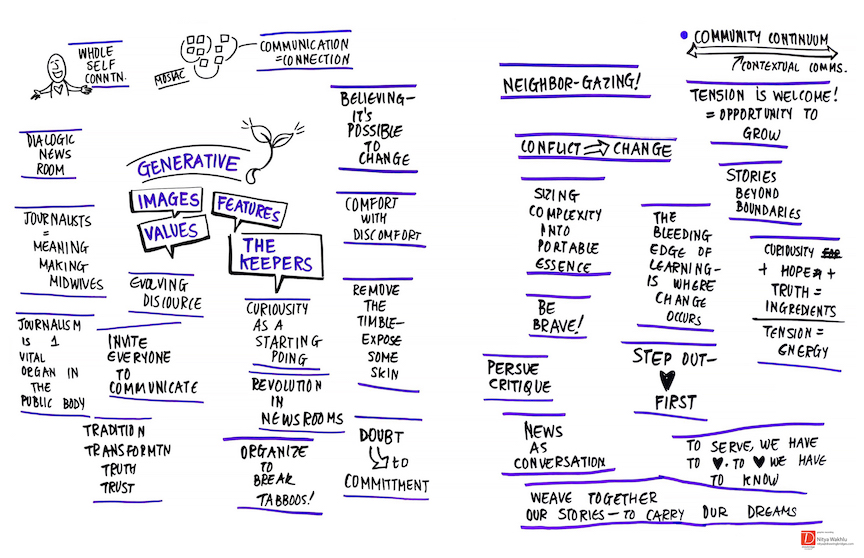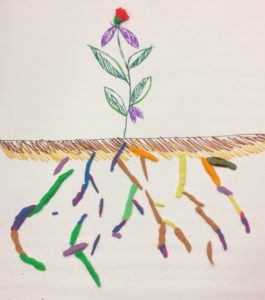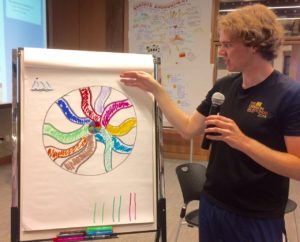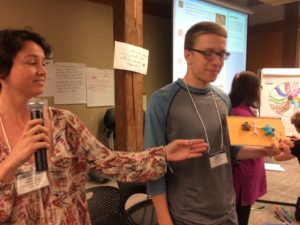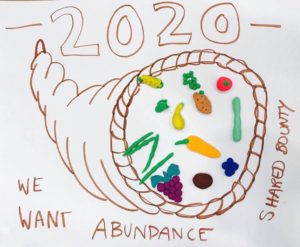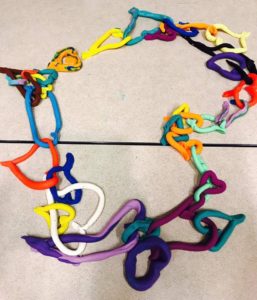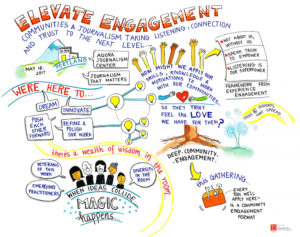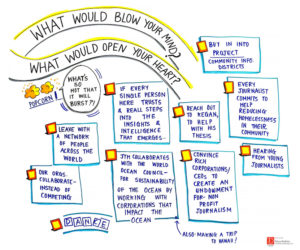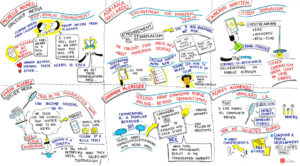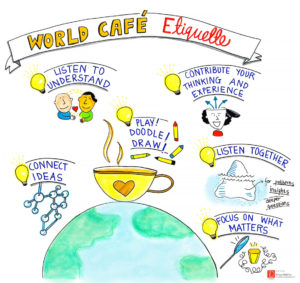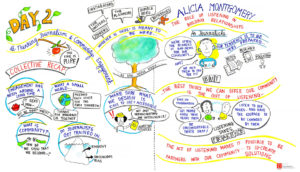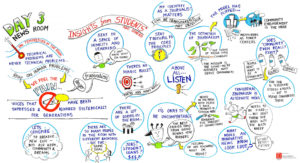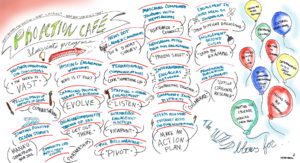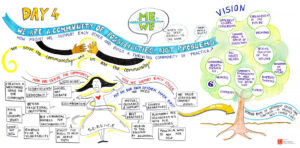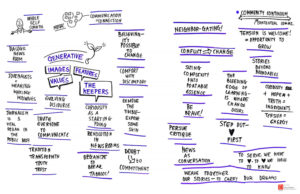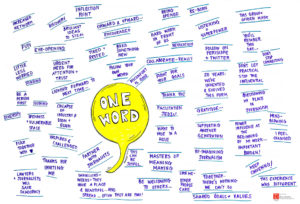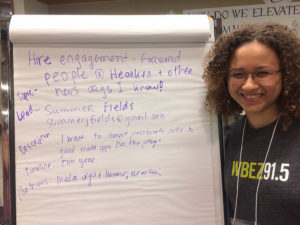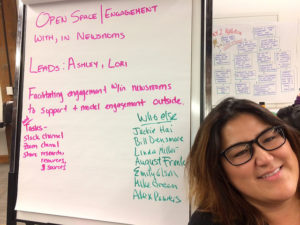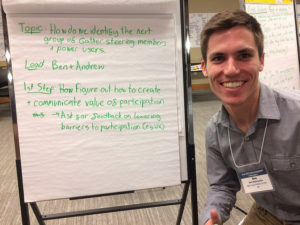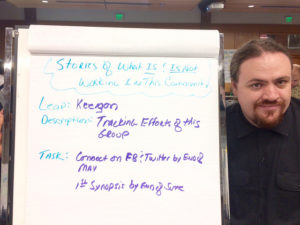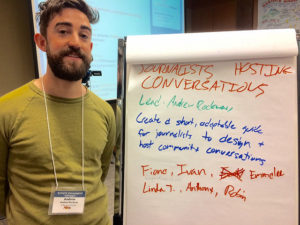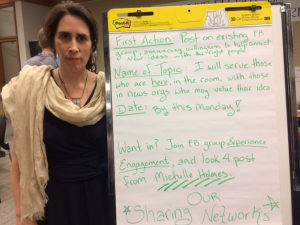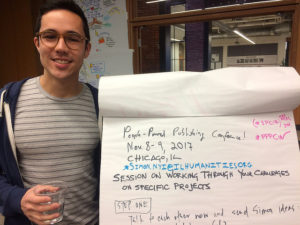ELEVATE ENGAGEMENT 2017
THEMES
Dear Friends,
Nine of us attending Elevate Engagement happily took on the task of paying close attention to what was said and documenting the emerging themes. We were participant observers, meaning that we were not on the outside looking in, but on the inside, reflecting back to the whole group what we all were learning. Of course, what seemed important was influenced by our own values/life experiences, by listening carefully for the deeply-felt truths of the speakers, by sensing the energy of the room, and also by our recent deep dive into the JTM report on the principles of civic communications.
As the conference proceeded, we documented the nuggets of insight that we heard in a shared document, clustering them as we went. It was interesting (and informed our sense of the themes) to see how often we captured the same “chunks,” which we also saw pop up on the Twitter feed. The shared document that contains the clustered chunks is over 20 pages long, so what I have produced here is a summary in outline form, with several illustrative quotes sprinkled throughout. If you’d like to see the full document, which also contains photos of some of August’s playdoh creations, go here. I’m sure that there are still some great nuggets in that longer doc that I didn’t do justice to in this summary, so if you see some ideas that aren’t represented, we should add them. Let me know.
This outline is not the final analysis, by any means. Some “data” still hasn’t been integrated, such as the full list of open space sessions topics, observations from any OS sessions that did not have one of our team present (especially on Sunday), the Pro Action Café, the postcards, and probably some other items I can’t think of right now. (We were able, however, to fold in the harvest that Nitya did in her amazing graphic recording posters, and also the pre-conference conversation quotes that were posted around Agora). It would also be great to take a closer look at what showed up most loudly in Twitter.
At this moment, I don’t know exactly what the next steps – if any – will be to do a “checks and balances” process that would incorporate more of that data, to get validation of the themes and identify what else is missing. The hosting and developmental evaluation team will be discussing that over the next few weeks, I’m sure. Be in touch if you want an update.
That said, my understanding of what is going to happen on Sunday morning is that you all will be looking at conference artifacts, including these notes, but also the other material that was generated and do a collective theming process. While I am so sorry to miss that (being now in Phoenix for my niece’s wedding), I am very excited that it’s going to happen. It will be a great way to do some of that checks and balances I just mentioned (“triangulation” in eval speak). I am so eager to see how your themes compare to/inform/deepen/shift what we have in these notes.
If you’d like to learn more about the process that our group of nine used, there are documents describing our method and the developmental eval. approach, in the Resources section of Gather. Also, feel free to contact me if you have questions or would like to talk more about developmental evaluation, or other ways to infuse the asking of critical questions into our work.
I know I said it so many times over the last couple of days, but I just need to put it in writing here, too: Thank you deeply to the U of O Journalism students and their incredible mentor Lori for joining me on this adventure: Alex Powers, August Frank, Emily Olson, Mark Kellman, Matt Gatie, Payton Bruni, Sydney Padgett, and Lori Shontz.
With love and appreciation,
Yve,
Developmental Evaluator with Journalism That Matters and The Agora Center
~~~~~~~~~~~~~~~~~~~
Yve Susskind, Ph.D.
Praxis Associates, LLC.
Planning, Facilitation, Research and Evaluation
for Education, Governmental and Non-Profit Organizations
Yve@PraxisAssociates.com
www.PraxisAssociates.com
www.linkedin.com/in/YveSusskind
�
ENGAGEMENT IS…
… Journalism
…About love and heart; it’s relational, not transactional
“Engagement is human beings opening their hearts to one another”
“Doing Journalism in a way that lets people know we love them”
“People are not getting the kinds of relationships they want with journalists when they go online to try to engage with them. People want more relational moments with journalists. And so do journalists.”
“Authenticity is what it really boils down to. People can tell when journalists do over-commercialization, and they hate it.”
“Journalism of past felt entitled to whatever info it wanted to take from community. Now has to build relationships”
“We want to see journalism be less transactional/extractive and more about partnerships.”
…Listening to what people are saying they want and need and responding to that:
- Information they need
- Engagement gaps
- Ways they’ve been hurt
- What they care about
- How they are being harmed
- How they are amazing and resilient
- How their stories inspire others
- What experiences they need
“If you aren’t reporting what they need, it’s sales—not journalism”
“Focus on making things useful for people rather than flagrant demonstrations of our own intelligence. Can someone under stress use this, is it what they need, not just I thought of this and it’s really shiny.”
“People today need experiences. Not more information. They are drowning in information”“Go out to those who have the most to lose and center the stories on what they have to say.”
…Always new
“I need to always stay in a place where I don’t know what I am doing, because if I ever come out of this humble and scared place then I am not learning and that doesn’t do any good to anyone.”
“Always experimenting and always learning from those experiments.”
…Empowerment
…Dialogue
“Debate is the norm in our culture. It means to beat down. What is here is dialogue. It means flowing through. It’s about curiosity, inquiry and making connections and that difference are source of creativity and information. Imagine journalism that is guided by dialogue.”
Putting people together across divides for conversation, for deep radical engagement – bringing people together and getting them to talk.
That we are all in this together.
“Let’s move away from ‘we talk, you listen’ to ‘we are all in this together.’”
“Imagine what they’ll say to you if they see you as a journalist. Now imagine what they’ll say to you if they see you as a citizen.”
�CHANGES THAT ARE NEEDED IN JOURNALISM
… To accept how Journalists are viewed by disenfranchised communities
Start by accepting that a lot of people don’t trust us to engage with us and don’t see us as a solution for their communities to thrive.
Ethnic media is not second-class.(see “are we “columbus’ing,” below”)
“Don’t be afraid to acknowledge the pain that we caused, the voices that have been suppressed and ignored systemically for generations.”
“Stop looking at communities as “problems to fix” – start listening. No missionary journalism”
“We’re often the bearers of bad news for our community. And! We ask them to pay for it.”
“There are people who don’t think media is a solution—they think it’s a problem”
“Yes, we need to focus on who is being harmed in society and give that voice, but we also need to be concerned about the harm we might be doing.”
Journalism needs to get over itself. Change journalism so it’s not a priesthood but a distributed environment where people can be heard/surrender.
“Does anyone else feel excited about the crumbling of the traditional institution?” [a bunch of hands go up!]
The professionalization of Journalism is a way of preserving white power and other forms of elitism
“There is elitism in writing that alienates people who otherwise might participate in conversation. (Good writing might mean good ideas, but bad writing doesn’t necessarily mean bad ideas)”
Get beyond the echo chamber.
“Journalists need to acknowledge their own bubble.
Just because journalists aren’t talking about something doesn’t mean no one is. Find the unheard stories.”
“We’re treating commentary like a higher form of journalism rather than talking to people and seeing facts.”
What would it mean if we stepped outside our engagement silos as journalists, organizers, facilitators, artists, and actually engaged across the silos to make a bigger difference?
The quickest way to get something done is not necessarily what is needed; engagement is not efficient. We need to build inefficiencies into the system because—relationships are inefficient.
Journalists need to stop standing outside, they need to become part of communities and be like hosts (in the way that hosts are not “objective” facilitators).
“There is no reason that newsrooms couldn’t do this kind of engagement that JTM does in communities. We have the model, it’s right here.”
Does the identity of the journalist matter? Yes.
“People had to go out and create their own papers because the people in the ethnic communities found that the other media were not competent to cover them.”
Transparency, not objectivity. The most important way to foster an engagement process is to be transparent.
We are learning how to not commercialize people’s lives.
“When I became a journalist my conversations changed. Every person became a potential source.”
�
WHAT COMMUNITIES NEED FROM JOURNALISM
To be heard – people want media to hear what matters to them
“The opportunity to be vulnerable with someone in the room is transformational.”
“Relationships can be an encounter. They don’t have to be persistent. We may never see each other again but the experience will last.” “Aloha: We’ve met and we’re in each others lives forever.”
“As member of the media, we are often seen as the person telling people that their community is damaged and their deeply held views are wrong. Instead we can offer them the feeling of being listened to, that they matter. Otherwise, maybe we are part of the problem (and we expect people to pay for that?!)”
Focus on community’s point of view, not the newsroom’s POV
For us to stop looking at communities as problems that we are there to fix and stop practicing missionary journalism, and start doing the work of listening to what the community needs.
To effectively cover communities with different value systems, we need to ask not about people’s opinions, but about their lived experiences.
“The newsroom has to forget it’s POV and appreciate the POV of the communities it serves.”
For us to engage first. Deep radical engagement implies engagement before the journalism. We must listen and engage and develop stories from there.
“What if you start thinking of the community as your newsroom when you need validation, feedback, when you need to know if you are on the right track, instead of going to your newsroom or your editor or your institution.”
And once we find out what people want and need, it might not be a story that is what should happen next (or it might not end at the story).
“If what we are here to do is meet community needs, what happens if the community doesn’t need content or story? If we’re in the business of meeting the needs of community, we might need to rethink what we do and how.”
“Take the story to the next step and facilitate actual change.”
Experiences that bring people together and build understanding. More information can actually create more splits between people.
For us to invest in people, not just in engagement
“Invite people for lunch, work with libraries, ask people for their story.”
Reporters gotta get out and cover the grassroots movements in the communities.
�
WHAT WE AS INDIVIDUALS NEED TO SUSTAIN OURSELVES
To know that it’s OK to be uncomfortable and to trust anyway
“Commit to and trust the inspiration that’s guiding you in your life and work, and really trust it and step right into it.”
“It’s OK to be uncomfortable and the best stories come when you break past your own borders and definitions.”
Crowdfunding engagement because we can’t wait for the institutions to change their priorities
Someone in the newsroom who’s bold enough to stand up and say, ‘How are we getting this wrong?’
THIS COMMUNITY OF PRACTICE NEEDS TO COLLABORATE IN ORDER TO…
(“if we could learn to be collaborative over competitive, that would blow my mind.”)
…Demonstrate impact but not necessarily scalability
“You have to give up the idea that this is going to go to a wider audience and scale.” aking community engagement work means doing work that doesn’t fit traditional metric and funding goals.”
…Create innovative ways to fund journalism/engagement because we can’t wait for the institutions to change their priorities
“New structures to enable these projects to live in communities, e.g., community information districts.”
“Work with funders to increase support for nonlinear ways to demonstrate impact when much is uncertain and unpredictable.”
…Develop a common vocabulary for clarity and understanding
Codify and standardize engagement processes in newsrooms across the country
What is community and how do we show how we belong?
There is no magic bullet for engagement, so helping us see the many ways.
…Figure out ways to transform this experience for people who weren’t in the room.
…Learn together about:
How to build engaged newsroom from the ground up
Ways to find the questions that people want to talk about, the pain points
Ways to engage with people with different ideological mindsets.
How do make journalism democratically beneficial and commercially viable.
How to increase spreadability of smaller sized efforts, not just scalability (study what kinds of things spread and how and how much/far)
Ways to demonstrate impact in the complex and constantly changing social systems we work in.
“Make the pitch to the community, not to the funder. Find the pain point in the community.”
“Let’s conspire – meaning to breathe together. To breathe new life into our work, community, dreams.”
CHALLENGES/QUESTIONS
Am I a journalist?
How can we become trusted agents of engagement when to some degree some of the journalism we have done is criminal to underserved communities?
Are we ‘Columbus’ing engagement that ethnic media, embedded in communities, have been practicing all along?
“Community journalists, civic journalists, rural journalists, journalists of color etc. have been doing this work for a really long time, unacknowledged and unfunded. Now that this kind of work has caught the attention of schools, industry, funders, there is a movement around it that doesn’t include or acknowledge those people. The gentrification of community centered journalism.”
Let’s be honest about what we mean by community.
“Are we using “community” as an excuse to pretend that we talked to a whole population of people. If 10 people show up, do we assume that that’s the people?”
“The word community makes me uncomfortable. Communities don’t want to be communities. They want to be fractured, tribal and segregated. So what are communities exactly? There is an ideal, but it does not reflect reality.”
Should we focus on changing the institutions that do have power and resources and that aren’t disappearing or should we just say screw ‘em, we’re going to innovate outside those institutions because those institutions have never served people of color? Or both?
Can media organizations embrace the idea of letting communities know we love them?
Can we collaborate and not just compete?
How do we reflect the values of the community but also refuse to normalize hate speech?
How can media stop obsessing about the married middle class and missing 100,000,000 low-income people?
We still need to define the journalism baby that’s in the bathwater. Don’t throw it all out.
J is about service not sales
The role of J is still to contribute to a healthy democracy
Engagement has been around for a long time. It’s sexy now. But we didn’t invent it.
Some of the large media institutions are providing valuable information that our cities need, such as that there is lead in drinking water in schools. And they are here and we can work with them.
“We don’t have to actually reinvent the wheel, we just have to remember where some of our foundations lie. We are public servants. That is our job, serving our communities.”
“We are essentially activists, people who give a shit, who serve the community and the way we do that should be responsible.”
Additions:
how engaged journalism can help communities thrive. More specifically, how could we take listening, connection, and trust to the next level?

